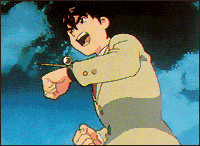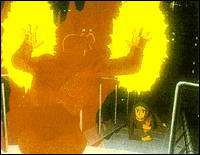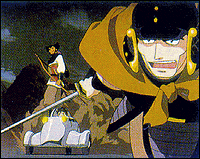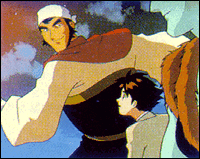 |


(page 3 of 5)
The Hallmarks of GIANT ROBO
Although GIANT ROBO does not really break new grounds in many aspects (story,
setting, fight sequences), it takes elements that may be worn, tired,
clichéd and puts
them together in such a way that yields a whole that is far greater
than the sum of its parts.
 Every character, for instance, gets at least two monologues. These
tragic and moving soliloquies serve to define the character within the
story or to set the tone for a certain part of the story. For example,
Taisou gets several chances to eloquently wax poetic
on life. Since Taisou serves as an older brother figure to Daisaku, two
of his expositions deal with him. The first is when he is out eating
and drinking with Tetsugyu, where he provides viewers with
background on Daisaku. He tells his tale in a sad reflective voice,
attempting to make us feel the heavy weight that Daisaku must bear. Every character, for instance, gets at least two monologues. These
tragic and moving soliloquies serve to define the character within the
story or to set the tone for a certain part of the story. For example,
Taisou gets several chances to eloquently wax poetic
on life. Since Taisou serves as an older brother figure to Daisaku, two
of his expositions deal with him. The first is when he is out eating
and drinking with Tetsugyu, where he provides viewers with
background on Daisaku. He tells his tale in a sad reflective voice,
attempting to make us feel the heavy weight that Daisaku must bear.

 The second occasion where Taisou speaks his mind is in his death
scene. After battling Albert of Impact he talks almost to Albert
and almost directly to Daisaku due to the way the scenes are directed
and cut. This serves two roles: first he shocks Albert showing him
that he threw the battle in Albert's favor to gain time. He gave
his life just for Daisaku and Giant Robo to gain time. Second he
attempts to give Daisaku the message that they are all fighting for
something greater than themselves and that is what his sacrifice is
about. He is doing it so that Daisaku will be able to re-awaken Giant
Robo and continue the battle. This skillful direction adds that element of
epic storytelling and
tragedy, driving the nail home. The second occasion where Taisou speaks his mind is in his death
scene. After battling Albert of Impact he talks almost to Albert
and almost directly to Daisaku due to the way the scenes are directed
and cut. This serves two roles: first he shocks Albert showing him
that he threw the battle in Albert's favor to gain time. He gave
his life just for Daisaku and Giant Robo to gain time. Second he
attempts to give Daisaku the message that they are all fighting for
something greater than themselves and that is what his sacrifice is
about. He is doing it so that Daisaku will be able to re-awaken Giant
Robo and continue the battle. This skillful direction adds that element of
epic storytelling and
tragedy, driving the nail home.
 Another cliche is the plot itself: a basic story that at
first seems rather predictable, but as it plays out we find that every
cause or action is seeded in some past and twisted around some
future. One example is Daisaku's dedication to Giant Robo. He not only
wants to help the IPO experts fight their battle, but his dedication also comes
from receiving control of Robo at his father's dying hands. He
is given a powerful force that was created by evil for evil purposes
and it is now turned to good. And Ginrei and Genya's troubled past
haunts them and drives them both to fight each other over
their father's memory and the tragedy that destroyed a nation 10 years
ago. Another cliche is the plot itself: a basic story that at
first seems rather predictable, but as it plays out we find that every
cause or action is seeded in some past and twisted around some
future. One example is Daisaku's dedication to Giant Robo. He not only
wants to help the IPO experts fight their battle, but his dedication also comes
from receiving control of Robo at his father's dying hands. He
is given a powerful force that was created by evil for evil purposes
and it is now turned to good. And Ginrei and Genya's troubled past
haunts them and drives them both to fight each other over
their father's memory and the tragedy that destroyed a nation 10 years
ago.
|
 |
|
 |
|
 |
|
 |
|
The IPO experts put up a final
attempt to stop the Vogler Sphere menace... |
 Plot twists abound as surprise characters show up and change
the tide one way or the other for a brief period. Characters even
end up turning out to be not what we expected. The story shapes the
characters and few finish the series as they started out. The most
proud are humbled and the most humble are given their final stand for
their beliefs. Even if one learns to expect such surprises in the end,
he is still caught unawares by villains being forced to acts of
heroism and heroes blinded by their own morality. Plot twists abound as surprise characters show up and change
the tide one way or the other for a brief period. Characters even
end up turning out to be not what we expected. The story shapes the
characters and few finish the series as they started out. The most
proud are humbled and the most humble are given their final stand for
their beliefs. Even if one learns to expect such surprises in the end,
he is still caught unawares by villains being forced to acts of
heroism and heroes blinded by their own morality.
 By episode 5 we finally get to meet the movers and
shakers of Big Fire. It turns out that even they may be puppets, or
are they? After all the sacrifices, all the bitter victories and the
redefinition of the remaining characters we have only covered the
first part of the war. Things such as Taisou's sacrifice at Beijing
serve to define Albert of Impact's last stand: Taisou saw beyond his
battle with Albert to the war. Taisou allowed Albert to kill him, which
caused Albert to be distracted from the goal of destroying Giant Robo. As
Albert see the drastic path that Taisou
took, he is forced to reevaluate what he would do next when
confronted with Genya's duplicity against Big Fire. By episode 5 we finally get to meet the movers and
shakers of Big Fire. It turns out that even they may be puppets, or
are they? After all the sacrifices, all the bitter victories and the
redefinition of the remaining characters we have only covered the
first part of the war. Things such as Taisou's sacrifice at Beijing
serve to define Albert of Impact's last stand: Taisou saw beyond his
battle with Albert to the war. Taisou allowed Albert to kill him, which
caused Albert to be distracted from the goal of destroying Giant Robo. As
Albert see the drastic path that Taisou
took, he is forced to reevaluate what he would do next when
confronted with Genya's duplicity against Big Fire.

 Even the sound track, utilizing the Warsaw Philharmonic orchestra
colors the setting with a magnificent grandeur. The powerful score
that plays during the destruction of Paris serves as a theme for the
tragedy of Bashtarlle. The music is in general
symphonic and very well keyed to the scenes. For instance when Paris
is being destroy by Big Fire the music is grand and sweeping. A chorus
accompanies the orchestra sweeping you along as you see the
Champs-Élysées destroyed in green fire. When Giant Robo
enters into
battle the music starts out slow with a beat that follows Robo's footsteps
and grows in stature and pace as the tension rises. Or, as a
total contrast we have the much more cheerful and light melodies that
accompany such scenes as when Taisou and Tetsugyu first try to get
Daisaku to join them for a night on the town. Even the sound track, utilizing the Warsaw Philharmonic orchestra
colors the setting with a magnificent grandeur. The powerful score
that plays during the destruction of Paris serves as a theme for the
tragedy of Bashtarlle. The music is in general
symphonic and very well keyed to the scenes. For instance when Paris
is being destroy by Big Fire the music is grand and sweeping. A chorus
accompanies the orchestra sweeping you along as you see the
Champs-Élysées destroyed in green fire. When Giant Robo
enters into
battle the music starts out slow with a beat that follows Robo's footsteps
and grows in stature and pace as the tension rises. Or, as a
total contrast we have the much more cheerful and light melodies that
accompany such scenes as when Taisou and Tetsugyu first try to get
Daisaku to join them for a night on the town.
 The soundtrack as a whole has a very dynamic range, covering all the
emotions of the series with a very strong variety. It has more tonal and
melodic variety than KISHIN HEIDAN but does not
have the sheer range of pieces present in the entirety of MACROSS PLUS. It
serves as an excellent aural setting for the story: grand and sweeping with
an occasional light moment but filled with a
certain set of repeating themes. The soundtrack as a whole has a very dynamic range, covering all the
emotions of the series with a very strong variety. It has more tonal and
melodic variety than KISHIN HEIDAN but does not
have the sheer range of pieces present in the entirety of MACROSS PLUS. It
serves as an excellent aural setting for the story: grand and sweeping with
an occasional light moment but filled with a
certain set of repeating themes.
|
 |
|
 |
|
 |
|
 |
|
Top: Daisuke races to Robo's side. Bottom:
Robo unleashes its entire arsenal. |
 But what truly makes GIANT ROBO epic is the direction. This story was
masterfully
told; the direction is what ties it all together. The placement of the
scenes, the lighting, all the little details add something. For example,
although Giant Robo's face is supposed to be immobile, the angles from which
we see it and the way the light plays
on it imbues Robo with an impressive sense of feeling. When he fires blast
after blast with his belt-cannons after the fleeing Ivan on what is left of
Uraeneus, the ominous rumbling from Robo provide
the sense that here is a being who can destroy buildings and he is very,
very angry. But what truly makes GIANT ROBO epic is the direction. This story was
masterfully
told; the direction is what ties it all together. The placement of the
scenes, the lighting, all the little details add something. For example,
although Giant Robo's face is supposed to be immobile, the angles from which
we see it and the way the light plays
on it imbues Robo with an impressive sense of feeling. When he fires blast
after blast with his belt-cannons after the fleeing Ivan on what is left of
Uraeneus, the ominous rumbling from Robo provide
the sense that here is a being who can destroy buildings and he is very,
very angry.
 The direction also shows its strength in the way the viewers are cut
back to flashbacks. Although viewers are shown the Tragedy of Bashtarlle
many times, each time it is from a different angle. Viewers see a little
more of what happened. This has the effect of making us think we are
seeing a story told a different way each time. In truth, all that is happening
however is that the director is adding a few more well-placed scenes
and bits of storytelling to these flashbacks so that more is
revealed. The flashbacks are juxtaposed with scenes of immense conflicts in
the present. This shattering dichotomy between
harrowing suspense and tantalizing revelation makes us hungry for more
of the past story line as well as what is going to happen next. The direction also shows its strength in the way the viewers are cut
back to flashbacks. Although viewers are shown the Tragedy of Bashtarlle
many times, each time it is from a different angle. Viewers see a little
more of what happened. This has the effect of making us think we are
seeing a story told a different way each time. In truth, all that is happening
however is that the director is adding a few more well-placed scenes
and bits of storytelling to these flashbacks so that more is
revealed. The flashbacks are juxtaposed with scenes of immense conflicts in
the present. This shattering dichotomy between
harrowing suspense and tantalizing revelation makes us hungry for more
of the past story line as well as what is going to happen next.
 |
 |


